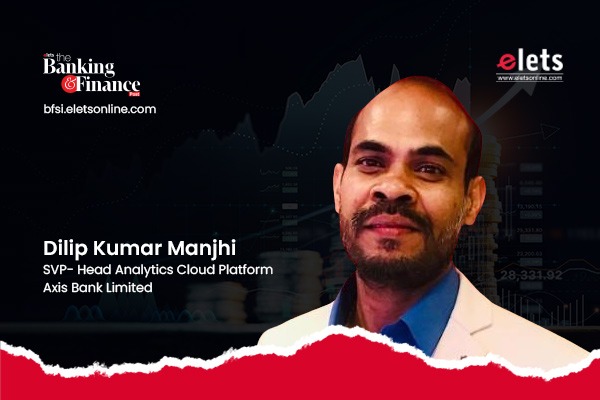Today’s financial institutions depend highly Analytics-Driven Approach. As Data Analytics is helping them in understanding the depth of business and form long as well short-term strategies. To know more about data analytics reducing the risk of fraudulent behavior, Rashi Aditi Ghosh of Elets News Network (ENN), had a conversation with Dilip Kumar Manjhi, SVP- Head Analytics Cloud Platform, Axis Bank Limited.
How significant is the role of analytics- driven strategies and tools for banks?
Bank has audit, compliance, risk, and many LOBs like retail, landing, CASA, asset, trading, mutual fund, cards, merchant, IB/MB platform etc. Most of business department needs to find the profit vs cost, ROI vs investment, and leakage.
Data Analytics provides depth of business, how it is doing, in what areas the bank needs to focus, and based on that, bank strategies are prepared for the short & long term.
Customer first resolution is key focus today. To resolve it, you need to have Customer 360 Profile, access to the last 5 customer interactions, customer sentiment – angry, neutral and all this needs a high volume of data to be parsed, analysed and fed to the customer center officer to deal with such kind of OMBUDSMAN Process. This situation refers to customer obsession and many banks’ attempts to serve customers with a customer centric data platforms and analytics tools.
The customer’s primary goal nowadays is resolution. To resolve customer problems, you must have a customer profile, access to the last 5 customer interactions, customers’ sentiments (angry or neutral), and all of this requires a large volume of data that must be parsed, analysed, and fed to the customer-centric officer to deal with such an OMBUDSMAN process. Customers’ preoccupation and various banks’ initiatives to service customers with customer-centric data platforms and analytics tools are examples of this type of circumstance.
Most banks have their own BIU (Business Intelligence Unit) to deal with Data Analytics required for various units of the bank. Board members, MD, and stakeholders need Data Analytics to strategise their charter and program to be kicked off .
Today any form of financial institution like investment banks, retail, commercial, NBFC, etc. depends on this Analytics- Driven Approach. As per McKinsey, the bank is a highly technology-driven function because it is very complex and serves Planet’s Money as a custodian.
Customer segmentation has become commonplace in the financial service industry. Will analytics-driven strategies help take segmentation to another level?
Customer segmentation is a key focus area in the digital world. Today, banks are built in a hyper personalisation framework for providing different customer segments. Banks cater to a range of customers like college students, tech-driven metro residents, future planners, senior citizens, digital transactors, etc., and they need to offer personified nudges to these customers. EXtra messages are boring, and info is irrelevant.
Digital native persona offers ‘Amazon discount vouchers’, future planner persona offers ‘pay insurance bill and get 1 per cent cashback. This kind of offers enhances the segment personalisation to bring out the “WOW Factor”.
Also Read | AI & ML redefining customers’ banking experience
Various nudges for credit cards, auto loans, personal loans, home loans etc, have a complex model behind this. Amazon earns 10 billion dollars from the customer segmentation framework. Starbucks earns 1 billion dollars from the segmented customised coffee per year. There is a high degree of analytics used to find and attract customers with various tests of coffee, weather, etc.
How important is it to identify behavioral patterns for banks? Will AI, ML and emerging technologies be the change makers in this regard?
AI, ML, and Deep Learning are becoming essential for loan disbursement. The app score is determined by the customer’s cibel score, expenditure, recovery, and earnings. The behavioural score card and risk appetite are based on several AI/ML-based models such as regression, classification, random forest, and Baison rapid tag usage scenarios where cars roll on the road work on the deep learning that the bank has used during any clearance statement.
The risk and propensity model is utlised with savings account pre-approved cards, PL/AL, and other products. Deep learning is used to manage TD (Term Deposit) drop and booking, digital PL conversion, morat specific model churns prediction for a savings account, life insurance for CASA, and other complicated AI models post covid.
Similarly, emerging technology like NFTs (Non-Fungible Trade) assets which is approved, and many companies have started working on it. It is a wallet, where you can put your money to buy the NFTs and trade it against any currency. Metaverse is the new emerging platform where JPMC is using for catalogue service – ONYX. The Bank of Baroda has adopted Metaverse for its lounges and various services.
Is Big Data helpful in identifying opportunities for up-selling and cross-selling?
Big data is the data platform to deal with structured, unstructured, semi-structure, and high volumes of data in terms of PB, and ZB. This captures data from most of the source systems using various ingestion frameworks, which apply the data quality check in the data applied for the Data Governance.
Data is being fed in real-time to the Big Data Platform. Macro batch as well as historical data is being taken care of. This system connects MDM and other data ref hub platforms, which gets the data and poses the output of the model data for Upselling and Cross selling purposes.
Let’s take an example of a customer, who has an account in a given bank, but he operates another bank for his transactions, credit card, Gpay etc. So the given bank can understand that this customer can be cross selling using their model running in the Big Data lake.
Thus, various business analysts connect to the big data platform where large amounts of consumable data is provided, and many different data sets to find the analytics for the upselling purposes. Big data enables data monetisation of the bank’s data to acquire customers for NTB (New to Bank) and provide various customer related services for ETB (EXisting to Bank).
Cyber fraud has reported a massive rise post the pandemic. How do you think Big Data Analytics can help reduce the risk of fraudulent behavior?
Data comes in real time from source systems to big data platforms using real-time streaming from various systems. We apply various fraud rules while data is streaming and catches the abnormal pattern.
Let’s assume that a customer is frequently using transactions in a particular account in the late hours using his IB/MB channel, and similarly transferring a very big amount which is unusual. Adding a beneficiary in the odd times to the account and doing transactions in an irregular manner is a symptom of fraud.
Also Read | AI/ML & IoT strengthen SaaS platforms
User behavior is a tech-enabled platform, which has become more digital post pandemic. There are higher chances of doing fraud by hacking. Recent news in the UK is Log4j, which was the epicenter of fraudulent activity. It is an open-source logging library which is commonly used by apps and services across the internet. If it is left unfiXed, attackers could break into the system, steal passwords, login, extract data and infect the network with the malicious software.
Big Data takes the user log data and passes it to SIEM platform which captures various click motivations and alerts the users for any of the fraudulent behaviour.
Elets The Banking and Finance Post Magazine has carved out a niche for itself in the crowded market with exclusive & unique content. Get in-depth insights on trend-setting innovations & transformation in the BFSI sector. Best offers for Print + Digital issues! Subscribe here➔ www.eletsonline.com/subscription/






















